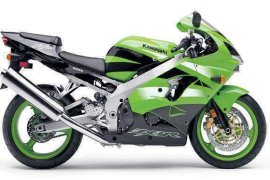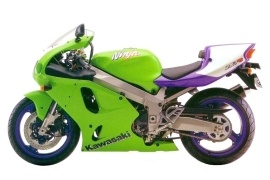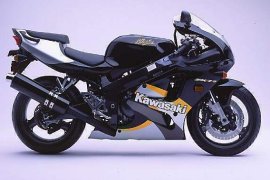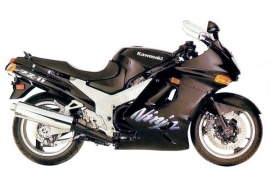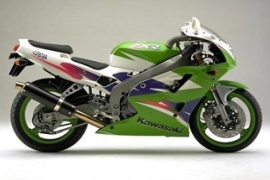KAWASAKI ZX-R Models/Series Timeline, Specifications & Photos
First production year: 1991
The Kawasaki Ninja ZX-9R was a sports motorcycle part of the Ninja family. It debuted in 1994 as a replacement for the Kawasaki GPZ900R and was manufactured until 2003, when it was replaced by the Kawasaki Ninja ZX-10R.
The bike was presented at the 1992 Paris Motor Show in September as a response to Honda's introduction of the 1992 CBR900RR Fireblade. The bike was based on the ZX-7 model, and the engine was developed from the same machine but shared only a few elements.
In 2002, the Japanese motorcycle manufacturer launched the Kawasaki Ninja ZX-9R, a sports motorcycle that underwent minor updates, such as new and improved four-piston Nissin brake calipers. It also received a stronger frame, a braced swingarm, ZX-12R-styled headlights, and air intakes.
The bike was fitted with standard features, such as a full fairing with a medium-sized windscreen, a single seat with an optional passenger seat cover, a four-into-one exhaust system, and lightweight three-spoke aluminum wheels.
In the braking department, the bike's wheels were fitted with two 320 mm discs tied to four-piston Nissin calipers on the front and a 220 mm disc with a single-piston caliper on the rear, offering optimum braking performance.
In the performance department, the 2002 Kawasaki ZX-9R Ninja had its heartbeat set by an 899cc four-stroke four-cylinder liquid-cooled engine that delivered an output power of 144 hp at 11,000 rpm and 101 Nm (75 lb-ft) torque at 9,200 rpm.
The Kawasaki Ninja ZX-7R was a sports motorcycle manufactured by Kawasaki from 1989 until 2003, when it was replaced by the GPX750R model. The Japanese ZX-7R remained essentially unchanged over its production time.
In 1996, the Japanese motorcycle manufacturer launched the Kawasaki ZX-7RR, a sports machine that differed from the base model through several things, like the adjustable head-stock angle, a swingarm pivot, and increased adjustability for the suspension.
The suspension was 28-position compression and 13-position rebound-adjustable on the front and 14-position rebound-adjustable on the rear. It also had a solo cowl with a different subframe, larger flat carburetors, a close-ratio transmission as standard, a heavier crankshaft flywheel, and Nissin front brake calipers.
In the aesthetic department, the bike was fitted with standard features, such as a full fairing with a medium-sized windscreen, a single seat, a four-into-one exhaust system with a silencer on the right side, and lightweight three-spoke aluminum wheels.
The bike's wheels were fitted with two 320 mm discs coupled to six-piston calipers on the front and a 220 mm disc with a single-piston caliper on the rear, offering excellent stopping power.
As for the power figures, the 1996 Kawasaki ZX-7RR had its soul brought to life by a 748cc four-stroke four-cylinder liquid-cooled engine that delivered an output power of 122 hp at 12,000 rpm and 79 Nm (58 lb-ft) torque at 9,300 rpm.
The Kawasaki ZX-7R was a sports motorcycle part of the Ninja series in Kawasaki's range, manufactured from 1989 until 2003. The bike replaced the GPX750R model and remained essentially unchanged over its production period.
From 1989 through 1995, in the United States market, the bikes were named ZXR-750 and ZXR-750R until 1996, when the maker dropped the ZXR designation worldwide, and the bikes were named ZX-7 and ZX-7R.
In 1995, the Japanese motorcycle manufacturer launched the Kawasaki ZX-7R Ninja, a sports motorcycle dressed in a full fairing and powered by a four-cylinder liquid-cooled engine with high top-speed capabilities.
In the visual department, the bike was equipped with standard features, such as a full fairing with a medium-sized windscreen, a two-piece dual seat with passenger grab rails, a four-into-one exhausts system with a muffler on each side, and lightweight three-spoke aluminum wheels.
The bike was built around a twin-spar aluminum frame with a 43 mm fully-adjustable telescopic fork on the front and an adjustable shock absorber on the rear, delivering excellent suspension performance and handling.
Underneath its fairing, the 1995 Kawasaki ZX-7R Ninja had installed a 748cc four-stroke four-cylinder liquid-cooled engine that delivered an output power of 112 hp with a peak force at 11,700 rpm and 76 Nm (56 lb-ft) torque at 9,500 rpm.
The engine was coupled to a six-speed manual transmission with a final chain drive, pushing the motorcycle to a top speed of 268 kph (167 mph).
The ZX-11 was a sports motorcycle made by Kawasaki from 1990 to 2001 and was also known as the ZZ-R1100. The bike replaced the ZX-10 model in 1990 and was replaced by the ZX-12C in 2001.
The Kawasaki ZX-11 was the fastest production bike with a top speed of 272-283 kph (169-176 mph) since its introduction until 1996 when the Honda CBR 1100XX was introduced with a top speed of 270-290 kph (170-180 mph).
The bike was fitted with standard features, like a full fairing with a medium-sized windscreen, a one-piece dual seat with a passenger grab rail, a dual exhaust system with a silencer on each side, and lightweight three-spoke aluminum wheels.
The bike's backbone was a pressed aluminum perimeter frame with a 43 mm preload and rebound-adjustable telescopic fork on the front, offering 120 mm wheel travel and a fully adjustable shock absorber on the rear with 112 mm wheel travel, delivering optimum suspension performance and handling.
The bike's wheels were fitted with two 320 mm discs coupled to four-piston calipers on the front and a 240 mm disc tied to a single-piston caliper on the rear, providing optimum braking performance.
In the performance department, the 1994 Kawasaki ZX-11 had its soul brought to life by a 1,052cc four-stroke liquid-cooled four-cylinder engine, boasting 147 hp with a peak force at 10,500 rpm and 110 Nm (81 lb-ft) torque at 8,500 rpm.
The Kawasaki ZXR 400 was a sports bike dressed in a full fairing manufactured from 1989 until 1999, when it was replaced by the Kawasaki Ninja ZX-4R. The ZXR 400 was one of the most popular 400cc sports machines when it was released.
The bike was made in two models, H and L. The H model was manufactured first and superseded by the L version in 1991. The ZXR 400 was discontinued in 1999 worldwide but remained in the UK until 2003.
In the aesthetic department, the bike was fitted with standard features, such as a full fairing with a small windscreen, a single seat, a four-into-one exhaust system with a silencer on the right side, and lightweight three-spoke aluminum wheels.
The bike was built around an aluminum diamond tubular double cradle frame with a 41 mm inverted Showa telescopic fork on the front and a Uni-Trek preload-adjustable shock absorber on the rear, offering optimum handling capabilities.
The braking power was handled by two 300 mm discs with four-piston calipers on the front wheel and a 240 mm disc with a dual-piston caliper on the rear wheel, offering excellent stopping power.
As for the power figures, the 1991 Kawasaki ZXR 400 had installed underneath its fairing a 398cc four-stroke four-cylinder liquid-cooled engine that delivered an output power of 65 hp at 13,000 rpm and 41 Nm (30 lb-ft) torque at 10,000 rpm.
